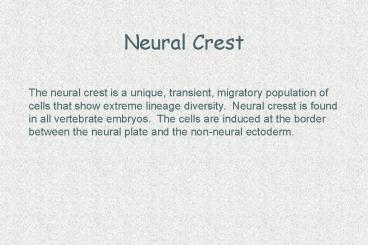Neural Crest - PowerPoint PPT Presentation
1 / 21
Title:
Neural Crest
Description:
... are derived from the cephalic neural folds which form from the frontal ... and jaw) is formed by the cephalic neural folds and pharyngeal arches 1 and 2 (mostly 1) ... – PowerPoint PPT presentation
Number of Views:151
Avg rating:3.0/5.0
Title: Neural Crest
1
Neural Crest
The neural crest is a unique, transient,
migratory population of cells that show extreme
lineage diversity. Neural cresst is found in all
vertebrate embryos. The cells are induced at the
border between the neural plate and the
non-neural ectoderm.
2
Neural crest migration
3
Cranial crest migration
4
Neural Crest Derivatives
- Neurogenic cells
- Pigment cells
- Mesenchymal cells
5
Neural crest map
6
Some of the cardiac defects produced by cardiac
neural crest ablation
7
Trunk neural crest
8
Early neural crest induction
Organizer
Ectoderm
Neural Crest Snail, Slug, FoxD3, Zic
9
Double gradient model of NC induction Aybar and
Major, 2002
- Neural crest is dependent on a gradient of BMP
in the ectoderm. - Wnt inhibitors inhibit the anterior neural plate
from generating neural crest. - After neural tube closure, BMPs, Wnts, FGF and
RA are required for late induction of NC.
10
Why do different levels of the axis produce
different types of cells?
- Leblanc and colleagues
- In vitro, young Hensens node can regulate the
expression of region-specific phenotypes in trunk
neural crest cells - A factor produced by Hensens node cell line
stimulates the expression of two cranial-specific
phenotypes (fibronectin and smooth muscle actin)
in trunk neural crest cells and decreases their
expression of a trunk specific phenotype
(melanin) - A metalloprotease that activates TGFbeta can
mimic the action of Hensens node in trunk neural
crest
11
Are different derivatives generated directly from
progenitors with a full repertory of crest fates?
- Sieber-Blum M and colleagues
- In vitro clonal analyses of posterior
rhombencephalic neural tube. - Mesenchyme cells derived from the neural tube
from somitic levels 1-3 contained 5 types of
clone-forming cells smooth muscle cells,
connective tissue cells, chondrocytes, sensory
neuron precursors, serotonergic (putative
enteric) neurons, and pigment cells. - Another type of clone was totally
pigmented,i.e. melanocytes only - A third type consisted entirely of smooth
muscle cells.
12
Development of the face
- The upper face (forehead, eyes) is patterned
mainly by the forebrain and optic vesicles. The
olfactory placodes and all of the ectoderm and
mesenchyme of the midface between the eyes and
mouth are derived from the cephalic neural folds
which form from the frontal prominence (Couly et
al., 1985). - The lower face (midface and jaw) is formed by the
cephalic neural folds and pharyngeal arches 1 and
2 (mostly 1).
13
Cranial neural crest
14
Figure 1
15
Figure 2
16
Table 1
17
Figure 3
18
Figure 4
19
Figure 5
20
Table 2
21
Table 3































